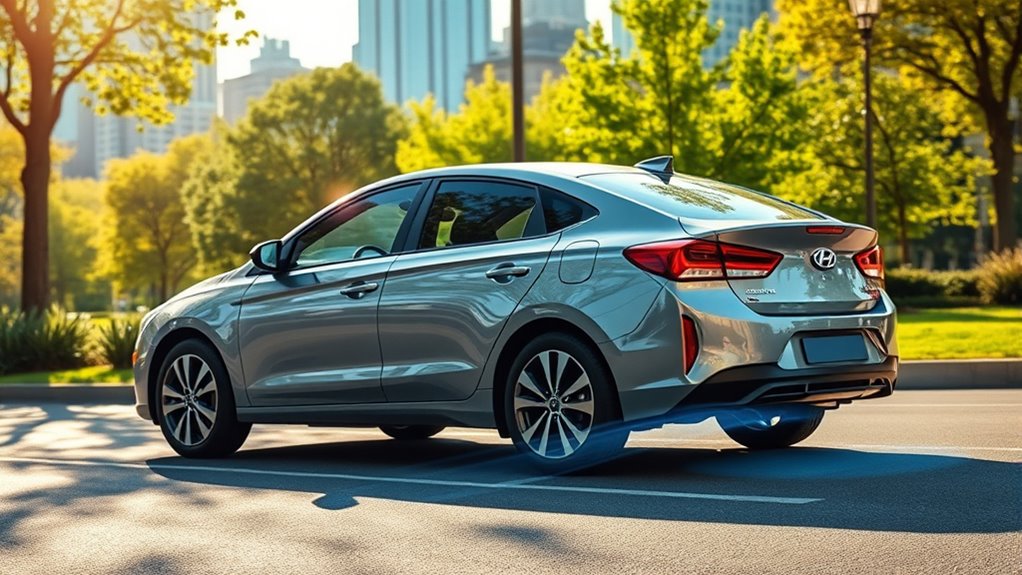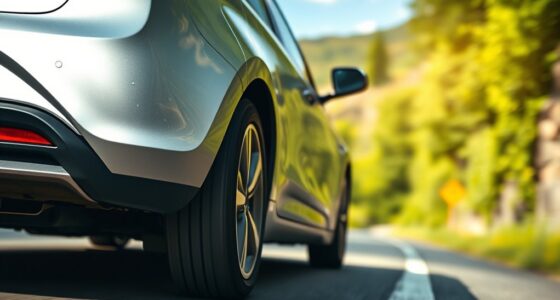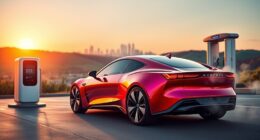Regenerative braking lets you convert kinetic energy into electricity when your hybrid or electric car slows down. Instead of wasting energy as heat, it takes that energy and recharges your battery. When you hit the brake pedal, the electric motor runs in reverse, generating power and reducing wear on traditional brakes. This means a smoother ride and longer driving range. If you’re curious about how this technology enhances efficiency and sustainability, there’s more to explore.
Key Takeaways
- Regenerative braking captures kinetic energy during deceleration and converts it into electrical energy for the vehicle’s battery.
- It functions by engaging the electric motor in reverse, generating electricity instead of relying solely on traditional brakes.
- This system enhances driving efficiency by recycling energy that would otherwise be lost as heat during conventional braking.
- Regenerative braking contributes to a smoother driving experience, providing gradual deceleration and reducing wear on brake components.
- By maximizing energy recovery, it extends the vehicle’s driving range and promotes eco-friendly transportation practices.

Have you ever wondered how electric and hybrid vehicles manage to extend their range while driving? One of the key innovations behind their efficiency is regenerative braking. This advanced braking system doesn’t just stop your car; it recycles energy that would otherwise be lost, helping you get more miles out of each charge.
When you hit the brakes in a conventional gas-powered vehicle, the kinetic energy that propels you forward dissipates as heat. However, with regenerative braking, the situation is quite different. As you decelerate, the system captures that kinetic energy and transforms it into electrical energy. This energy recovery process feeds power back into the car’s battery, allowing you to use it later for acceleration. Essentially, you’re turning your car into a mini power plant, making every stop a chance to recharge.
You might be wondering how this works in practical terms. When you press the brake pedal, the regenerative braking system engages the electric motor, which then operates in reverse. Instead of consuming energy, it generates electricity as it slows down the vehicle. This not only increases efficiency but also reduces wear on traditional braking components, like discs and pads, since they’re used less frequently.
Now, let’s talk about how this impacts your driving experience. You’ll likely notice a smoother deceleration when you drive a hybrid or electric car equipped with regenerative braking. Instead of a jarring stop, you’ll experience a gradual slowdown, which can feel more comfortable and controlled. Plus, because the system is constantly recovering energy, you may find that you don’t need to charge your vehicle as often, especially on short trips or in city driving conditions where braking is frequent. Additionally, implementing pest-free strategies in your environment can enhance your overall experience by ensuring that your vehicle and surroundings are well-maintained.
Regenerative braking systems aren’t just a tech gimmick; they’re a crucial part of the overall efficiency strategy for electric and hybrid vehicles. By harnessing energy that would otherwise be wasted, these cars increase their range and reduce their environmental impact. So next time you’re driving your hybrid or electric vehicle, remember that each stop isn’t just about slowing down; it’s also about recycling energy and maximizing your driving experience.
Frequently Asked Questions
How Does Regenerative Braking Affect Overall Vehicle Performance?
Regenerative braking considerably enhances your vehicle’s performance by improving energy recovery and braking efficiency. When you decelerate, it captures kinetic energy that would otherwise be lost, converting it back into usable power for your car. This process not only extends your vehicle’s range but also reduces wear on traditional brake components, leading to less maintenance. Overall, you’ll notice smoother stops and better energy management, making your driving experience more efficient and enjoyable.
Can Regenerative Braking Systems Fail or Malfunction?
Yes, regenerative braking systems can fail or malfunction. Common issues include sensor failures or battery problems, which can hinder energy recovery. If your vehicle’s braking system shows warning lights or unusual behavior, it’s essential to have it examined. Many modern systems have malfunction detection features that alert you to potential problems. Regular maintenance helps prevent braking system failures and ensures your regenerative braking operates efficiently, enhancing your overall driving experience.
Is Regenerative Braking Effective in Cold Weather?
You might find that regenerative braking can be less effective in cold weather. The battery cold weather performance often drops, impacting energy recovery. When temperatures dip, the brake system integration may not function as smoothly, leading to reduced efficiency. However, many modern hybrid and electric vehicles are designed to adapt to these conditions. So, while you might notice a difference, your car’s system still aims to maximize energy recovery whenever possible.
How Does Regenerative Braking Impact Maintenance Costs?
Regenerative braking can considerably lower your maintenance costs. By reducing wear on traditional brake components, it enhances system durability, meaning you won’t have to replace brake pads as frequently. This translates into cost savings over time, as you’ll spend less on repairs and replacements. Plus, with fewer components wearing out, your vehicle’s overall longevity improves, making regenerative braking not just an efficient energy-saving feature but also a smart financial choice.
Are There Differences Between Hybrid and Electric Regenerative Braking Systems?
When you glide to a stop, hybrid and electric regenerative braking systems dance differently. Hybrids blend traditional brakes with electric ones, capturing energy but with energy recovery limits. You might feel a softer shift as the system kicks in. In contrast, pure electric systems maximize battery efficiency, harnessing nearly every bit of energy. Picture a smooth wave, where every stop powers your journey, transforming wasted energy into a charge for the road ahead.
Conclusion
In the world of hybrid and electric cars, regenerative braking is like a superhero, saving energy while you drive. By harnessing the power of deceleration, these vehicles not only boost their efficiency but also contribute to a greener planet. So, the next time you hit the brakes, remember: you’re not just stopping; you’re recycling energy and paving the way for a sustainable future. Embrace this innovation, and let every journey be a step towards a cleaner tomorrow.









